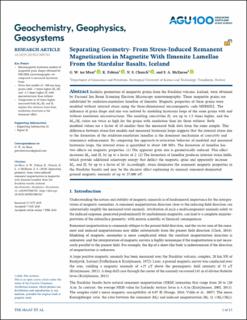| dc.contributor.author | ter Maat, Geertruida Wilhelmina | |
| dc.contributor.author | Fabian, Karl | |
| dc.contributor.author | Church, Nathan Stewart | |
| dc.contributor.author | McEnroe, Suzanne | |
| dc.date.accessioned | 2021-04-15T06:34:18Z | |
| dc.date.available | 2021-04-15T06:34:18Z | |
| dc.date.created | 2020-02-21T14:48:21Z | |
| dc.date.issued | 2020 | |
| dc.identifier.citation | Geochemistry Geophysics Geosystems. 2020, 21 (2), . | en_US |
| dc.identifier.issn | 1525-2027 | |
| dc.identifier.uri | https://hdl.handle.net/11250/2737827 | |
| dc.description.abstract | Realistic geometries of magnetite grains from the Stardalur volcano, Iceland, were obtained by Focused Ion Beam Scanning Electron Microscopy nanotomography. These magnetite grains are subdivided by oxidation‐exsolution lamellae of ilmenite. Magnetic properties of these grains were modeled without internal stress using the three‐dimensional micromagnetic code MERRILL. The influence of grain shape and size was isolated by modeling hysteresis loops of the same grains with and without exsolution microstructures. The resulting coercivities Hc are up to 1.5 times higher, and the Mrs/Ms ratios are twice as high for the grains with exsolution than for those without. Both modeled values are a factor of 10 smaller than the measured bulk data from the same sample. This difference between stress‐free models and measured hysteresis loops suggests that the internal stress due to the formation of the oxidation‐exsolution lamellae is the dominant mechanism of coercivity and remanence enhancement. By comparing the approach‐to‐saturation behavior of modeled and measured hysteresis loops, the internal stress is quantified to about 100 MPa. The formation of lamellae has two effects on magnetic properties. (1) The apparent grain size is geometrically reduced. This effect increases Mrs and Hc by up to a factor of 2. (2) The formation of lamellae produces internal stress fields, which provide additional anisotropy energy that deflect the magnetic spins and apparently increase Mrs and Hc by up to a factor of 10. Accordingly, stress dominates the remanent magnetic properties in the Stardalur basalts and may be the decisive effect explaining its unusual remanent‐dominated ground magnetic anomaly of up to 27,000 nT. | en_US |
| dc.language.iso | eng | en_US |
| dc.publisher | AGU, American Geophysical Union and Wiley | en_US |
| dc.rights | Navngivelse 4.0 Internasjonal | * |
| dc.rights.uri | http://creativecommons.org/licenses/by/4.0/deed.no | * |
| dc.title | Separating geometry- from stress-induced remanent magnetization in magnetite with ilmenite lamellae from the Stardalur basalts, Iceland | en_US |
| dc.type | Peer reviewed | en_US |
| dc.type | Journal article | en_US |
| dc.description.version | publishedVersion | en_US |
| dc.source.pagenumber | 15 | en_US |
| dc.source.volume | 21 | en_US |
| dc.source.journal | Geochemistry Geophysics Geosystems | en_US |
| dc.source.issue | 2 | en_US |
| dc.identifier.doi | 10.1029/2019GC008761 | |
| dc.identifier.cristin | 1796587 | |
| dc.relation.project | Norges forskningsråd: 295864 | en_US |
| dc.description.localcode | ©2020. The Authors. This is an open access article under the terms of the Creative Commons Attribution License, which permits use, distribution and reproduction in any medium, provided the original work is properly cited. | en_US |
| cristin.ispublished | true | |
| cristin.fulltext | original | |
| cristin.qualitycode | 2 | |

